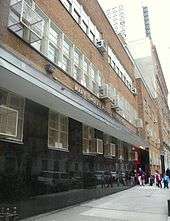Mary Lindley Murray
Mary Lindley Murray is known in American Revolutionary folklore as the Quaker woman who in 1776 held up British General William Howe after the British victory against American forces at Kips Bay. According to James Thatcher, a surgeon travelling with Washington's army, Murray treated Howe and his generals to cake and wine and delayed them several hours as the American rebels got away safely and undetected. As Thatcher puts it:
When retreating from New York, Major General Putnam, at the head of three thousand five hundred continental troops, was in the rear and the last that left the city. In order to avoid any of the enemy that might be advancing in the direct road to the city, he made choice of a road parallel with and contiguous to the North River, till he could arrive at a certain angle, whence another road would conduct him in such a direction as that he might form a junction with our army. It so happened that a body of about eight thousand British and Hessians were at the same moment advancing on the road, which would have brought them in immediate contact with General Putnam, before he could have reached the turn into the other road. Most fortunately, the British generals, seeing no prospect of engaging our troops, halted their own, and repaired to the house of a Mr. Robert Murray, a Quaker and friend of our cause; Mrs. Murray treated them with cake and wine, and they were induced to tarry two hours or more, Governor Tryon frequently joking her about her American friends. By this happy incident General Putnam, by continuing his march, escaped a rencounter with a greatly superior force, which must have proved fatal to his whole party. One half hour, it is said, would have been sufficient for the enemy to have secured the road at the turn, and entirely cut off General Putnam s retreat. It has since become almost a common saying among our officers, that Mrs. Murray saved this part of the American army. [1]

MARY MURRAY
The important service rendered to the American cause by Mrs. Murray, who saved Gen. Putnam and his troops from a surprise by the British, has been mentioned.* One of her descendants has communicated a few additional particulars concerning her. Her maiden name was Mary Lindley, and she was of a Quaker family. She was born in Pennsylvania, and resided in that colony for some years after her marriage to Robert Murray. Her eldest son, Lindley—so extensively known for his work on the grammar of the English language—was born at the town of Swatara, near Lancaster. In 1753 she removed with her family to the city of New York, where Murray became ere long one of the wealthiest and most respected merchants. He had joined the Society of Friends from a persuasion of the truth of their creed and approbation of their customs, and though he was one of the four or five gentlemen who first rode in their coaches, he had a dislike to everything like luxury or ostentation, always terming his carriage his 'leather convenience'. Mrs. Murray is remembered in the family tradition as * See Vol. II., p. 294.
a person of great dignity and stateliness of deportment. Her disposition is described by a tribute to her memory in the memoirs of her son, Lindley Murray: "My mother was a woman of amiable disposition, and remarkable for mildness, humanity and liberality of sentiment. She was indeed a faithful and affectionate wife, a tender mother, and a kind mistress. I recollect with emotions of affection and gratitude her unwearied solicitude for my health and happiness."
About the year 1764 Mr. Murray removed his family to England and remained there, on account of his health, till 1775. He was descended of a noble Scottish family, whose younger branches, like many other scions of nobility, had found themselves obliged, in impoverished and troublous times, to seek their fortune in the New World. It was natural, therefore, that he should retain their prejudices, and he continued disposed to loyalism during his life, while his wife, as the anecdote recorded of her testifies, joined with all her sympathies in the contest for liberty in her native land. The scene of her detention of the British officers was 'The Grange', a small country seat at Murray Hill, some time since removed to make way for the improvements of the growing city.
Mrs. Murray died December 25, 1782, (0. S.) Many of her descendants are now living in New York: those of her son, John Murray, and her daughters, Beulah—Mrs. Martin Hoffman—and Susannah—the wife of a British officer—Col. Gilbert Colden Willett, a grandson of the English Lieutenant-Governor Colden. [2]
In popular culture
The tale is the basis of the Rodgers and Hart musical Dearest Enemy and the 1957 play Small War on Murray Hill.
A Staten Island Ferry named the Mary Murray was launched in 1937 and in service until 1975.
References
- A Military Journal During the American Revolutionary War, from 1775 to 1783, James Thatcher, Richardson and Lord, 1823
- The Women of the American Revolution, Volume III, Elizabeth Fries Ellet, Baker and Scribner, 1850, page 376